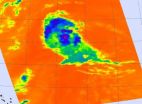3-D movies in your living room -- without the glasses
2012-08-16
(Press-News.org) Lounging on a sofa while watching a 3D movie is an exquisite pleasure for many film fans. Be that as it may, those nettlesome 3D glasses might diminish the fun somewhat. That's why television manufacturers are working on displays that can recreate the spellbinding magic of three-dimensional television images – without the glasses. Though prototypes of these TV screens already exist, consumers will not have to wait much longer for the market introduction of these autostereoscopic displays. Neverthe-less, the content might be a bit problematic: The 3D movies currently available on Blu-ray are based on two different perspectives, i.e., two images, one for each eye. However, autostereoscopic displays need five to ten views of the same scene (depending on the type). In the future, the number will probably be even more. This is because these displays have to present a three-dimensional image in such a manner that it can be seen from different angles – indeed, there is more than one place to sit on a sofa, and you should be able to get the same three dimensional impressions from any position.
Researchers at Fraunhofer Institute for Telecommunications, Heinrich-Hertz Institute, HHI in Berlin recently developed a technology that converts a Blu-ray's existing 3D content in a manner that enables them to be shown on autostereoscopic displays. "We take the existing two images and generate a depth map – that is to say, a map that assigns a specific distance from the camera to each object," says Christian Riechert, research fellow at HHI. "From there we compute any of several intermediate views by applying depth image-based rendering techniques. And here's the really neat thing: The process operates on a fully automated basis, and in real time." Previous systems were only capable of generating such depth maps at a dramatically slower pace; sometimes they even required manual adaption. Real-time conversion, by contrast, is like simultaneous interpretation: The viewer inserts a 3D Blu-ray disc, gets comfortable in front of the TV screen and enjoys the movie – without the glasses. Meanwhile, a hardware component estimates the depth map in the background and generates the requisite views. The viewer is aware of nothing: He or she can fast forward or rewind the movie, start it, stop it – and all with the same outstanding quality. The flickering that could appear on the edges of objects – something that happens due to imprecise estimations – is imperceptible here.
The researchers have already finished the software that converts these data. In the next step, the scientists, working in collaboration with industry partners, intend to port it onto a hardware product so that it can be integrated into televisions. Nevertheless, it will still take at least another calendar year before the technology hits department store shelves. At the IFA trade show in Berlin from August 31 to September 5 the technology can be tested: An autostereoscopic 3D screen will be set up right in front of a sofa corner at Booth 10 in Hall 11.1. Visitors can select from the various 3D Blu-ray discs, and as the disc is played, the system will convert it live: the visitors just relax and enjoy the movie – without the glasses.
INFORMATION: END
ELSE PRESS RELEASES FROM THIS DATE:
2012-08-16
Fairfax, Va.--The popular spice turmeric packs more than just flavor — it shows promise in fighting devastating viruses, Mason researchers recently discovered.
Curcumin, found in turmeric, stopped the potentially deadly Rift Valley Fever virus from multiplying in infected cells, says Aarthi Narayanan, lead investigator on the new study and a research assistant professor with Mason's National Center for Biodefense and Infectious Diseases.
Mosquito-borne Rift Valley Fever virus (RVF) is an acute, fever-causing virus that affects domestic animals such as cattle, sheep ...
2012-08-16
Everyone knows the adage: "If something sounds too good to be true, then it probably is." Why, then, do some people fall for scams and why are older folks especially prone to being duped?
An answer, it seems, is because a specific area of the brain has deteriorated or is damaged, according to researchers at the University of Iowa. By examining patients with various forms of brain damage, the researchers report they've pinpointed the precise location in the human brain, called the ventromedial prefrontal cortex, that controls belief and doubt, and which explains why some ...
2012-08-16
Ramadan dinners in the Danish Parliament, staff parties without either pork or alcohol and prayer rooms at the airport are all examples of how religion is becoming more visible in public spaces.
"Prior to the mass migration of the '60s, '70s and '80s, almost all Danes shared similar values and were members of the national Christian church, so religion was not an issue in everyday life. There was no need to discuss neither one's own nor another person's religious viewpoint, and secularisation was a matter of course. Today, it is difficult to be in a public place, read ...
2012-08-16
VIDEO:
An animation of satellite observations from Aug. 13-16, 2012 shows the birth of the Atlantic Ocean hurricane season's eighth tropical depression that strengthens into Tropical Storm Gordon. This visualization was...
Click here for more information.
NASA has been watching the low pressure system called System 93L for the last week, and late on August 15 it organized into Tropical Depression 8, then Tropical Storm Gordon. NOAA's GOES-13 satellite captured a visible ...
2012-08-16
Astronomers using data from NASA's Hubble Space Telescope have caught two clusters full of massive stars that may be in the early stages of merging. The clusters are 170,000 light-years away in the Large Magellanic Cloud, a small satellite galaxy to our Milky Way.
What at first was thought to be only one cluster in the core of the massive star-forming region 30 Doradus (also known as the Tarantula Nebula) has been found to be a composite of two clusters that differ in age by about one million years.
The entire 30 Doradus complex has been an active star-forming region ...
2012-08-16
In the quest to understand how the world's weather moves around the globe, scientists have had to tease apart different kinds of atmospheric movement, such as the great jet streams that can move across a whole hemisphere versus more intricate, localized flows. Much the same must currently be done to understand the various motions at work in the great space weather system that links the sun and Earth as the sun shoots material out in all directions, creating its own version of a particle sea to fill up the solar system.
"People think of the sun as giving out light and ...
2012-08-16
HOUSTON - A metabolic protein that nourishes cancer cells also activates tumor-promoting genes by loosening part of the packaging that entwines DNA to make up chromosomes, a team led by scientists at The University of Texas MD Anderson Cancer Center reports in the Aug. 16 issue of Cell.
Working in cell lines and mouse models of glioblastoma multiforme, the most lethal form of brain tumor, senior author Zhimin Lu, Ph.D., associate professor of Neuro-Oncology at MD Anderson, and colleagues show that pyruvate kinase M2 (PKM2) fuels tumor growth by influencing a histone protein.
DNA ...
2012-08-16
PHILADELPHIA, August 16, 2012 – Without other risk factors, all Americans born between 1945 and 1965 should have a one-time screening for the hepatitis C virus (HCV) according to new recommendations being published early online today in Annals of Internal Medicine, the flagship journal of the American College of Physicians. The Centers for Disease Control and Prevention (CDC) also recommends that all persons identified with HCV should receive a brief alcohol screening and intervention and be referred to appropriate care and treatment services for HCV and related conditions.
Up ...
2012-08-16
Thermafiber has officially announced the release of a new continuous insulation product. RainBarrier HD (Heavy Density) is a rigid insulation board with a consistent 6.0pcf density throughout the entire thickness. The consistent density from top to bottom simplifies installation by eliminating the need to orient the insulation in a certain direction like other mixed-density products. The increased density enhances the rigidity and ease of fabrication. The mineral wool board is non-combustible and provides exceptional R-values of 4.2 per inch of thickness. In addition to ...
2012-08-16
MINNEAPOLIS – People who are free of dementia and have high levels of a protein that indicates the presence of inflammation have relatives who are more likely to avoid the disease as well, according to a new study published in the August 15, 2012, online issue of Neurology®, the medical journal of the American Academy of Neurology.
"In very elderly people with good cognition, higher levels of C-reactive protein, which is related to inflammation, are associated with better memory," said study author Jeremy M. Silverman, PhD, with Mount Sinai School of Medicine in New ...
LAST 30 PRESS RELEASES:
[Press-News.org] 3-D movies in your living room -- without the glasses




